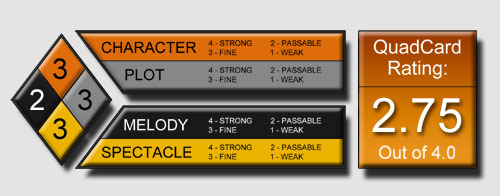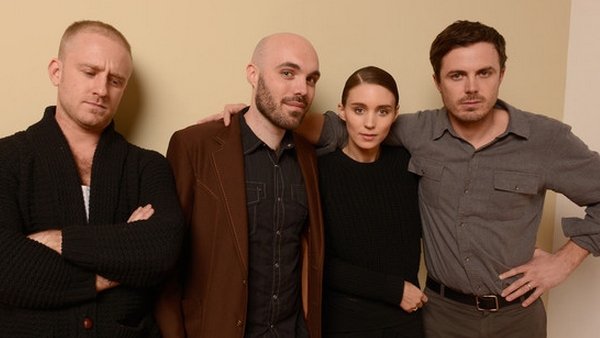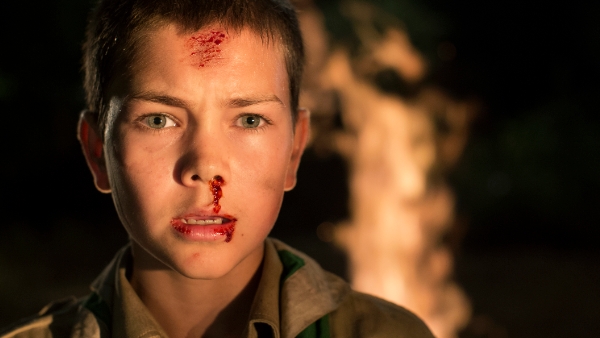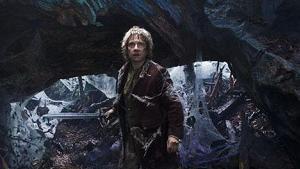 Good news for fans of Peter Jackson’s visual tour guide through Middle-earth: the dividing line that split critics over last year’s first entry in the lord of the ring’s adaptation of The Hobbit (subtitled An Unexpected Journey) has shrunk in the second episode, The Desolation of Smaug. That’s to say that a year after the starting point for the new franchise met with mixed reception, Jackson seems to have gotten back on his feet somewhat, proving that all of the groundwork laid in An Unexpected Journey was indeed worth his audience’s while; the new film plays like a roller coaster, punctuated by dips, twists, loop-the-loops, and every other sort of thrill expected from high-flying carnival amusements.
Good news for fans of Peter Jackson’s visual tour guide through Middle-earth: the dividing line that split critics over last year’s first entry in the lord of the ring’s adaptation of The Hobbit (subtitled An Unexpected Journey) has shrunk in the second episode, The Desolation of Smaug. That’s to say that a year after the starting point for the new franchise met with mixed reception, Jackson seems to have gotten back on his feet somewhat, proving that all of the groundwork laid in An Unexpected Journey was indeed worth his audience’s while; the new film plays like a roller coaster, punctuated by dips, twists, loop-the-loops, and every other sort of thrill expected from high-flying carnival amusements.
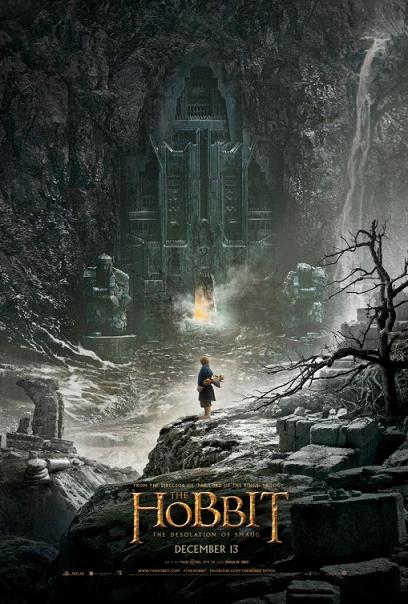 But the experience also happens to include a strong sensation of post-frivolity exhaustion, and not the good kind, either. Theme parks only strap you in for a couple of minutes, give or take; Jackson locks his viewers down for over two and a half hours. In theory, that sounds like a great time at the movies, at least if we remember the Rings films and their treasure trove of excitements fondly, but in practice The Desolation of Smaug, while certainly fun, showcases several of Jackson’s weaknesses as a storyteller in not-insignificant ways that ultimately make the joy ride he’s assembled here somewhat more punishing than flat-out rewarding; put another way, there are a few too many times when we wish that we could get off.
But the experience also happens to include a strong sensation of post-frivolity exhaustion, and not the good kind, either. Theme parks only strap you in for a couple of minutes, give or take; Jackson locks his viewers down for over two and a half hours. In theory, that sounds like a great time at the movies, at least if we remember the Rings films and their treasure trove of excitements fondly, but in practice The Desolation of Smaug, while certainly fun, showcases several of Jackson’s weaknesses as a storyteller in not-insignificant ways that ultimately make the joy ride he’s assembled here somewhat more punishing than flat-out rewarding; put another way, there are a few too many times when we wish that we could get off.
Picking up from the ending of An Unexpected Journey, we meet our company of stoic, bumbling, mostly vertically challenged heroes – represented mostly through the words and actions of the eponymous hobbit, Bilbo Baggins (Martin Freeman), the brooding leader of Middle-earth’s Dwarven coalition, Thorin Oakenshield (Richard Armitage), his right-hand man, the venerable Balin (Ken Stott), and, of course, the wise old wizard, Gandalf (Ian McKellen) – in media res as they flee on foot from Orcs; so the great race of The Desolation of Smaug begins. They scarcely hold still for the entire movie, rushing from one location to another, colliding with capital-T trouble everywhere they go. (Apparently Middle-earth was much less sympathetic to wandering adventurers in Bilbo’s day. Frodo has it easy.)
Describing all details of the troupe’s various journeys here is an article unto itself; that “tour guide” quip is meant in all earnestness, as The Hobbit films, much like their predecessors (an awkward term given that the former is the antecedent to the latter), are largely predicated on the importance of good world-building. Jackson opens up Middle-earth in a big, often gorgeous way throughout The Desolation of Smaug, covering an enormous amount of ground as he takes us through the spider-infested thickets of Mirkwood, the Elven kingdom that sits therein, the decrepit, frozen human hamlet of Lake-town, the haunted fortress of Dol Guldur, and – at long last – the great mountain, Erebor, the final destination of all of the characters’ travels, where we meet the colossal, scaly tyrant of the film’s title.
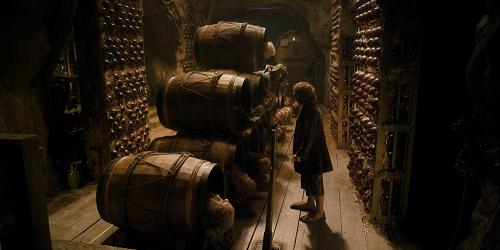
Let’s get this out of the way: whether you’re a Tolkien fanatic (aside: purists will find Jackson’s efforts here absolutely infuriating), a casual fan of the series, or a Jackson jihadist, you’re buying a ticket to The Desolation of Smaug just to see the dragon. Period. Sure, yes, you probably want to see where the rest of the narrative, such as it is, meanders, but the star attraction for nearly everyone here will be the product of Weta’s impressive efforts wrangling Smaug (pronounced Sm-ow-guh) for his big reveal in the picture’s last hour. In a movie that’s liberally peppered with digitized FX, Smaug takes the crown, as he rightly should; Bilbo’s many ass-kissing testimonials to the creature’s immensity alone don’t do Smaug any justice, and neither will any review you read. He’s CG gold.
The trouble, though, is that the road leading up to him isn’t exactly smooth. As An Unexpected Journey did Herculean legwork to set up The Desolation of Smaug, so too does The Desolation of Smaug set up the final installment, next year’s There and Back Again. Oh, the follies of franchises; it’s essential stuff, but it’s not all handled with the same degree of finesse, so often when the action lulls for the umpteenth time to stress an essential piece of exposition or an important thematic detail, The Desolation of Smaug drags. Partly, this is just the burden of knowing that there’s one more film left, and that everything we see unfold before us is just another landmark visited on our path toward a momentous, raucous climax; even for those who haven’t read the books, this much is made obvious through endless portent and foreshadowing. It’s a necessary evil, but it’s hard not to wish Jackson paid as much attention to plot points as set pieces.
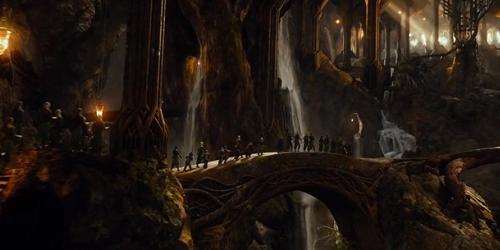
Fortunately, those FX-laden sequences are worth all of the trouble and then some. Jackson’s post-Rings filmography shows what happens when he’s allowed to self-indulge with cool technological toys, but they also affirm his keen eye for exciting, compelling action; an extended chase down a river, where Dwarves float in barrels as Elves and Orcs in turn try to run them down, fits the “theme park ride” concept perfectly without feeling gimmicky, cute or, worst of all, video gamey. These are the best moments that The Desolation of Smaug has to offer, and there are many of them and more to keep our attention in between the moments of plot bolstering that end up weighing the film down. It’s simply too bad that the connective tissue binding them didn’t receive the same amount of though on Jackson’s part.
G-S-T RULING:
There are, at least, wonderful actors a-plenty doing all of the requisite story maintenance here, though this time around the note-perfect Freeman steps back to allow his fellow cast members more screen time than they perhaps deserve. The best addition, surprisingly, is Evangeline Lilly, playing Tauriel, a steely but compassionate Elven warrioress who serves as a welcome counterpoint to returning Rings veteran Orlando Bloom’s stiff attempts at acting; neither show up in Tolkien’s novel (Tauriel is a whole-cloth invention for the film), yet to their credit they earn their keep here as a linchpin element of unity in a divided world threatened by the oft-hinted at overwhelming evil we know from the Rings films.
But that in and of itself is troubling; this a case of just-too-muchery, more for the sake of more, which is neither strictly a negative thing nor the best way to approach bringing every nook and cranny of Tolkien’s world to life. By the time The Desolation of Smaug ends, we’re looking forward to the next picture, but not as much as we’re simply yearning for the Jackson who made Lord of the Rings into such a laudatory example of narrative cohesion over a decade ago.
